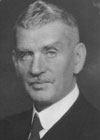Nicolai Rygg
(economist, central banker, deep state actor) | |||||||||||||||||||||||
|---|---|---|---|---|---|---|---|---|---|---|---|---|---|---|---|---|---|---|---|---|---|---|---|
 | |||||||||||||||||||||||
| Born | 29 February 1872 Stavanger | ||||||||||||||||||||||
| Died | 27 September 1957 (Age 85) | ||||||||||||||||||||||
| Nationality | Norwegian | ||||||||||||||||||||||
| Alma mater | University of Oslo, University of Göttingen, University of Geneva | ||||||||||||||||||||||
| Interest of | Francis Sejersted | ||||||||||||||||||||||
| Relatives | Andreas Nilsen Rygg | ||||||||||||||||||||||
Norwegian economist and Governor of the Central Bank of Norway (Norges Bank). His "independent" economic austerity policies contributed to the severe economic troubles in the 1920s and 1930s. He was behind the 1928 toppling of the first Labour Party cabinet in Norway, which only sat for sixteen days. He continued to work in an "unpolitical" role during the German occupation 1940-45.
| |||||||||||||||||||||||
Nicolai Theodorius Nilssen Rygg was a Norwegian economist and Governor of the Central Bank of Norway (Norges Bank). His "independent" economic austerity policies contributed to the severe economic troubles in the 1920s and 1930s. He was behind the 1928 toppling of the first Labour Party cabinet in Norway under Christopher Hornsrud, which only sat for sixteen days. He continued to work in an "unpolitical" role during the German occupation 1940-45.
Contents
Background
Rygg grew up in economically fairly solid conditions in Stavanger. He was a brother of journalist Andreas Nilsen Rygg.[1]
He finished his secondary education in 1889, and graduated from the Royal Frederick University with the cand.jur. degree in 1894. He was a deputy judge in Vesterålen District Court before studying economics in Göttingen and Genève in 1896 to 1897, later statistics in the United States from 1904 to 1905.
Statistics Norway
He worked in Statistics Norway from 1898, and from 1907 he doubled as secretary in Statistics Norway and research fellow at the Royal Frederick University. His special field was social statistics, and he also chaired Norsk Forening for Socialt Arbeide from 1909 to 1915. From 1910 to 1913 he was a professor at the Royal Frederick University in economics and statistics.[1][2] From 1913 to 1920 he was director of Statistics Norway.
Governor of the Central Bank of Norway
In November 1920 he took over as Governor of the Central Bank of Norway. Rygg was governor during perhaps the most turbulent period in Central Bank's history. The 1920s were characterized by a banking crisis and the "par policy", an effort to return the value of the krone to pre-war parity with gold. The banking crisis was at its worst in 1922–23, while the par policy led to great economic difficulties in the years 1925–28. Both of these policy areas contributed to making Rygg and the Central Bank very unpopular, both among politicians and the rest of the population. In 1931, Norway was forced to leave the gold standard again, along with, among others, Great Britain and Sweden. This helped to put the parity policy in a bad light.
Toppling the Labor Party government
In February 1928, leader of the Liberal Party, Johan Ludwig Mowinckel, tabled his no-confidence motion against Christopher Hornsrud's Norwegian Labour Party government following a recommendation from Nicolai Rygg. Rygg replied, to a question from Mowinckel, that the Labor Party government had to be thrown out in order to restore confidence in the economic conditions in the country. The Farmers' Party, the Conservative Party wanted to overthrow the government, but did not have a majority on their own. Mowinckel's no-confidence motion on behalf of the Liberal Party was thus decisive for the government to fall.[3] Mowinckel himself became the new prime minister. During the Labor Party's growing political influence from 1935, Rygg had to fight constant attempts by the political authorities to gain control of the Central Bank and monetary policy.[1][4][5]
Gold reserves
From 1938, Rygg was the driving force behind the preparations to evacuate Norway's gold reserve in the event of war. The measures he had put in place, and his initiation of the so-called gold transport during the German invasion of Norway in April 1940, were decisive for the gold reserve being brought to safety in Great Britain.[6] After following the gold transport for some distance, Rygg returned to Oslo. In accordance with the provisional regulation on the monetary system in Norway, adopted by the government on 22 April 1940, Rygg and the management in Oslo were relieved of their duties[7]. Norges Bank was to formally monitor the gold holdings, and Arnold Ræstad was appointed by the government as governor of the central bank in Rygg's place.
However, Rygg and the Oslo directorate continued their work throughout the German occupation. On 24 April 1940, the bank offered, in cooperation with the Administrative Council, to redeem the German occupation forces' own notes, "Reichskredittkassenscheine", against a claim on the so-called "Hauptverwaltung der Reichskredittkassen" in Germany.[8] This provided the basis for the Germans' so-called "occupation account" in Norges Bank, from which they had withdrawn NOK 8.1 billion at the end of the war. However, Rygg and Norges Bank were not significantly criticized during the investigations after the war. After the government's return in 1945, Norges Bank's directorate, the "London directorate" under Arnold Ræstad's leadership, was relieved of its duties and the Rygg and Oslo directorates were reappointed.
After retiring as Central Bank Governor at the age of 74, he returned to his academic writing. He was a fellow of the Norwegian Academy of Science and Letters.[1]
References
- ↑ a b c d http://www.snl.no/.nbl_biografi/Nicolai_Rygg/utdypning
- ↑ http://www.snl.no/.nbl_biografi/Ebbe_Hertzberg/utdypning |
- ↑ Nicolai Rygg, Norges Bank i mellomkrigstiden. Oslo: Gyldendal, 1950.
- ↑ http://www.snl.no/Nicolai_Rygg
- ↑ http://www.allkunne.no/default.aspx?menu=156&id=3714
- ↑ Han som var forberedt da krigen kom, article in Aftenposten 7. juni 2015
- ↑ Norges Bank under okkupasjonen. (Oslo: J. Chr. Gundersen, 1945), 9–12.
- ↑ Norges Bank under okkupasjonen. (Oslo: J. Chr. Gundersen, 1945), 26-27.